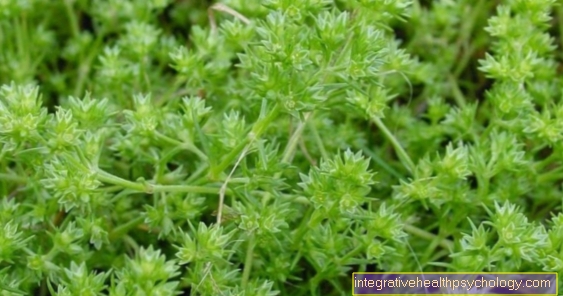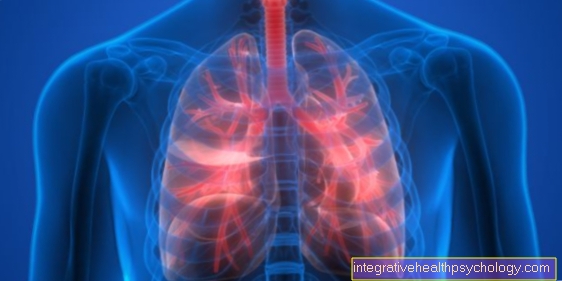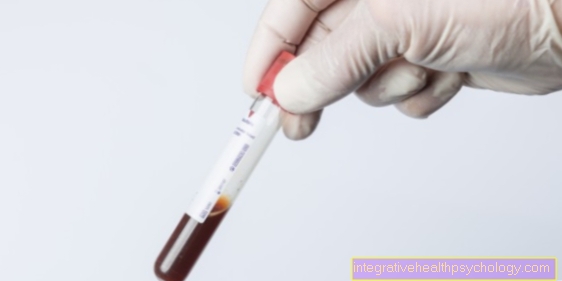Detergent allergy
introduction
Allergies are divided into 4 different types. A detergent allergy is a contact allergy. The contact allergies are in turn assigned to allergy type IV. This type of allergy is also known as a late-type allergy. In contrast, allergies such as hay fever or food allergies belong to allergy type I. These are allergies of the immediate type. The difference between the different types of allergies is that the body reacts to the allergen in a different way and over a different period of time. In the case of detergent allergy, the immune system creates certain cells that respond specifically to the allergen causing it. Up to 72 hours pass between contact with the allergen and the appearance of the first allergic symptoms. In contrast, with hay fever, the first symptoms appear after a few minutes after repeated allergen contact.
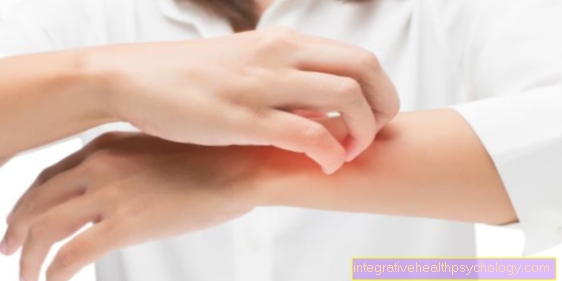
causes
In a detergent allergy, the body's immune system reacts excessively to an ingredient in the detergent that is actually not dangerous, but is classified as dangerous by the body. The allergy occurs because allergenic particles of the detergent stick to the laundry and prolonged skin contact occurs when the garment is worn. Hence the term contact allergy.
The consequence is repeated allergic symptoms after contact with this ingredient. The allergic symptoms arise from the fact that the body's immune system forms defense cells specifically against the allergen. These are activated again and again when the body is confronted with the allergen. The cells bind to various receptors and thus trigger allergic symptoms. Numerous substances contained in various detergents can have a potentially allergenic effect. So far, a certain ingredient has not been determined to be the cause of a detergent allergy. Not only detergents, but also fabric softeners contain a wide variety of potentially allergenic ingredients. Infants and toddlers in particular are particularly sensitive to fabric softener ingredients, so it is recommended to wash clothes without fabric softener in the child's first years. However, there are now more and more suppliers of fabric softener variants that are labeled with additives such as sensitive and should be better tolerated. It is not yet clear why certain people are allergic to detergent ingredients and others not. As with most other allergies, it is a hypersensitivity that cannot be predicted based on certain characteristics. What is certain, however, is that people with pre-existing skin diseases such as neurodermatitis have an increased risk of a detergent allergy. Likewise, people with pre-existing allergies have an increased risk of developing further allergies.
Symptoms of a detergent allergy
With a detergent allergy, symptoms such as itching, redness, swelling and rashes occur in the area of the skin covered by clothing. These can be wheals, blisters or eczema. Particularly dry, flaky skin can also indicate an allergy. Symptoms in the respiratory tract such as runny nose or cough can also occur less frequently.
The symptoms do not appear immediately after contact with the allergen but only after a certain period of time. This can be up to 72 hours. In rare cases, a very strong allergic reaction called anaphylactic shock can occur. This is a potentially life-threatening situation, which can be associated with swelling of the airways (shortness of breath), palpitations, drop in blood pressure and cardiac arrest. There are no symptoms that specifically indicate a detergent allergy, which makes diagnosis relatively difficult.
also read: Symptoms of an allergy
skin rash
There is no specific rash in people with a detergent allergy. The allergy can manifest itself in various types of rash. Diffuse reddening of the skin, blistering, pimple formation, eczematous oozing foci and dry skin peeling can occur.
You may also be interested in this topic: Allergy rash
Pimples
Numerous small, reddish pimples in the skin area covered by clothing can be an indication of a detergent allergy. However, pimples can have many other causes, such as a skin condition, excessive sun exposure, or other types of allergies.
Shortness of breath
Shortness of breath is a very rare symptom of a detergent allergy. The detergent allergy usually only affects the skin area without involving the respiratory tract. In some situations, a detergent allergy can trigger anaphylactic shock. This is the maximum variant of an allergic reaction. The mucous membranes of the airways can swell very quickly, causing shortness of breath and life threatening. The only adequate therapy here is the immediate administration of medication and securing the airways.
therapy
The only adequate therapy for a detergent allergy consists in the complete avoidance of the triggering allergen. If the patch test (the potential allergen is fixed on the skin for 48 hours using a plaster in order to be able to observe a reaction) a certain ingredient is found to which the body is allergic, then only detergents that do not contain this ingredient should be used . If there is only suspicion of a detergent allergy, switching to skin-friendly / skin-sensitive / allergy-friendly products can be a way to make the allergic symptoms disappear. If the use of a new, particularly skin-friendly, detergent results in a significant improvement in the symptoms, this indicates that there was a detergent allergy.
In the acute stage, skin creams containing cortisone may provide relief. However, they should not be used over a long period of time and are only symptomatic, not causal therapy.
More information on this topic: Therapy of an allergy
Duration
If the body reacts allergic to a certain detergent ingredient, the allergic symptoms usually persist as long as the body is exposed to the substance causing it. Only the avoidance of the allergen leads to a decrease in symptoms.
diagnosis
At first, it is not that easy to infer a possible trigger from skin symptoms such as redness, rash or itching. Especially since the time between allergen contact and the onset of allergic symptoms often lasts many hours. If skin symptoms keep recurring, it is therefore advisable to consult a dermatologist. They will take a close look at the rash and take a medical history, i.e. ask certain questions that can provide clues as to whether it could be an allergic reaction.
If the dermatologist suspects a contact allergy, a specific skin test can be carried out. This is known as a patch test. Here, substances are applied to the patient's back that are suspected to be responsible for the allergy. They are masked there with the help of a special plaster. Since contact allergies are late-type allergies, it can take up to 72 hours for an allergic reaction to occur. Therefore, the substances to be tested should be left on the skin for at least 48 hours before the test is evaluated. Then the patches will be removed and the skin will be examined for symptoms such as redness, rash, or swelling. Another 24 hours later, the skin is examined again. Usually, special test series are used in the patch test. These contain substances that are known to frequently trigger contact allergies. Patch tests are carried out less frequently with samples of the suspected allergy-causing substance brought by the patient. If the patch test reveals skin symptoms such as redness or swelling, it can be determined exactly which ingredients the body has reacted with an excessive immune response.
Read more about this: Allergy diagnostics
Course of disease
The course of a detergent allergy can only be positively influenced by avoiding allergens. If the body continues to confront the allergen, there will be no improvement in the symptoms. If the allergen is avoided, however, there is usually a significant decrease in skin symptoms within a relatively short time without permanent damage.










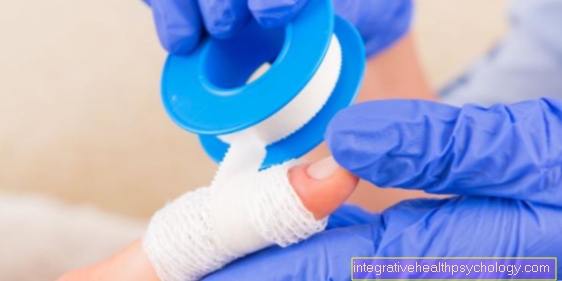





.jpg)



